A Complete Guide to Milling Cutter Tools
In machining, end mills are super popular because they’re so versatile and useful, making them the most commonly used cutting tool. For a lot of machining newbies, they’re often the first tool to try. There are so many different kinds of end mills, so in this article, we’re diving into the basics and some tips to help you pick the best one. This will help you choose the most cost-effective and efficient end mill for your needs, whether you’re buying or using them!
Contents

What Are Milling Cutter Tools?
End mills, they’re used in machining, spinning around to remove material from the surface of a workpiece. This helps create the shapes, contours, and surfaces you want. You’ll mostly find them on milling machines and machining centers. Solid end mills are usually made of HSS or carbide. But hey, depending on your budget, you can go for insert types, like PCD or CBN, on the cutting edge if you’re looking for better durability. So, end mills are pretty versatile, cutting all kinds of materials – metals, wood, composites, plastics, you name it. They’re perfect for industries like automotive, aerospace, mold making, new energy, and even healthcare.
.gif)
Types of Milling Cutter Tools
Milling cutters come in various types, each designed for different applications and performance levels. Choosing the right milling cutter based on your specific needs is crucial. Below are some common types of milling cutters. You can quickly refer to the table for an overview.
| Category | Type | application | |
|---|---|---|---|
| END Mill | Square end mills |  | They’re perfect for operations like slotting, edge milling, and contouring, especially when it comes to making right-angle edges and flat-bottomed grooves. |
| Ball nose end mill |  | They’re ideal for high-precision finishing of smooth curved surfaces, 3D profiles, and complex contours. | |
| Bull nose end mills |  | Perfect for handling rounded edges, reducing chipping, and ideal for transition areas. | |
| Rounding end mills |  | Great for external edge rounding and chamfering, deburring, and improving both the appearance and safety of part edges. | |
| Undercutting End Mills |  | Used for machining undercuts, grooves, overhangs, or complex parts with hard-to-reach geometries. | |
| Micro end mills |  | Ideal for micro-machining, electronic components, medical devices, and micro-mold manufacturing. | |
| Face Mills | Face Milling cutter |  | Perfect for large-area flat milling, capable of both efficient rough machining and high-precision surface finishing. |
| Slotting Cutters | T-Slot Cutters |  | Ideal for machining T-slots, used for fixture fixing or the installation and positioning of sliding mechanisms. |
| Saw Cutters | 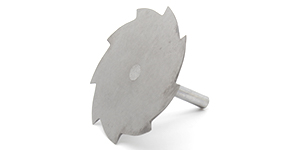 | Ideal for high-precision machining of deep, narrow slots or separating thin workpieces. | |
| Specialized Cutters | Dovetail cutter | 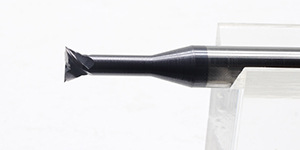 | Used for machining dovetail-shaped triangular grooves on workpieces. |
| Thread milling cutters | 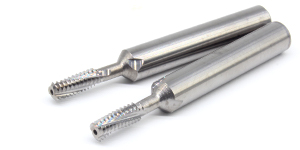 | Ideal for internal and external thread machining. | |
| Concave and Convex Milling Cutters | 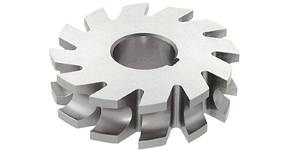 | Ideal for machining concave or convex curved profiles on workpieces, commonly used in mold and decorative processing. | |
| Cylindrical Milling Cutter | 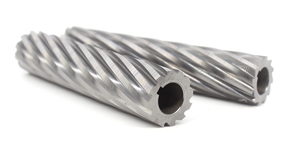 | Mainly used for large-area flat milling or precision profile machining. |
Next, let’s take a closer look at each type of milling cutter in detail.
1. End Mills
The end mill, being the most common type, has cutting edges on both the tip and the sides, which means it can cut in any direction.
1.1 Square end mills

Also known as flat end mills, square end mills have a flat tip and a 90° cutting edge angle. If you’re dealing with tasks like slotting, pocketing, or profiling, these tools are a great choice.
1.2 Ball nose end mill

Also called a ball end mill, it has a hemispherical tip, and its rounded cutting edges are perfect for applications that require smooth, curved surfaces or 3D contouring.
1.3 Bull nose end mills

Also known as corner radius end mills, they’re similar to square end mills, but with a rounded cutting edge instead of the sharp 90° angle. This design helps extend tool life and prevent chipping, making them perfect for handling rounded edges.
1.4 Rounding end mills

With a specific radius on the cutting edge, these are specially designed for machining rounded corners. They’re perfect for chamfering the edges of parts with a rounded finish.
1.5 Undercutting End Mills

The tip is spherical, kind of like a lollipop, which is why they’re also called lollipop cutters. They’re mainly used for machining hard-to-reach areas and parts with undercut structures, like in the mold-making industry.
1.6 Micro end mills

Micro end mills are ultra-small tools, usually with diameters under 4mm, and sometimes even smaller than 1mm. These little guys are widely used in industries where precision and attention to detail matter, like electronics and tiny parts. And yes, even dentists use micro end mills to “fix” your teeth when they’re in trouble!
2. Face Mills

There are two types: Adjustable PCD Face Milling and Welding PCD Face Milling. With their large diameter heads, these tools can cover a bigger cutting area, which boosts efficiency. The interchangeable insert design allows for both fast material removal during roughing and high-precision finishing, helping to reduce costs.
3. Slotting Cutters
Slotting cutters are milling tools designed for cutting slots or narrow grooves.
3.1 T-Slot Cutters

The teeth are perpendicular to the outer diameter, and the cutting edge forms a “T” shape. The head is wider, making it perfect for machining T-slots. These are often used to provide mounting and sliding positions for fixtures or fastening devices.
3.2 Saw Cutters

The blades are thinner, designed for machining narrow grooves or slots with a depth greater than the blade thickness.
4. Specialized Cutters
These are non-standard end mills, specially designed and optimized for specific machining tasks to solve unique processing problems with particular workpieces.
4.1 Dovetail cutter

A type of forming end mill, it has a wide tip and a trapezoidal cutting edge, specifically designed for machining dovetail slots. It can cut dovetail structures with a trapezoidal cross-section, often used in the processing of sliding components or fixed connections.
4.2 Thread milling cutters

This is a type of end mill specifically designed for machining internal or external threads. Unlike traditional tap threading, a thread mill uses a milling process to cut the threads, offering better stability and more functionality.
4.3 Concave and Convex Milling Cutters

A type of forming end mill, it’s specifically designed for machining curved profiles on the surface of a workpiece.
4.4 Cylindrical Milling Cutter

The cutting edges are distributed along the outer perimeter of a cylindrical body, making it ideal for milling flat surfaces or large areas of a workpiece.
Milling Cutter Material Options
The choice of end mill material directly affects machining performance and tool life. Based on structure, they are divided into solid (like HSS, carbide, etc.) and insert types (such as PCD, CBN, etc.). By selecting the right material and structure, you can improve machining efficiency and product quality.
1. Solid Milling Cutters
1.1 HSS milling cutter
High-speed steel (HSS), it’s an alloy with stuff like tungsten, molybdenum, and chromium in it. It makes the tool super tough, so HSS end mills don’t chip so easily. But here’s the thing – when it hits over 600°C, it starts losing its hardness. So, it’s really good for medium to low-speed cutting. And yeah, you’ll need to use coolant to keep things stable while cutting. One of the good parts is that HSS has moderate hardness, meaning it’s easy to re-sharpen when it gets dull. It’s not as precise as carbide, but it’s cheaper, so if you’re working with low-speed machining, it’s a solid, cost-effective choice.
1.2 Cemented Carbide Milling Cutter
Cemented carbide (hard alloy) is made by sintering hard particles like tungsten carbide (WC) with a binder, usually cobalt (Co), through powder metallurgy. It’s way harder and more wear-resistant than HSS tools. And even at 1000°C, it still holds its ground, which makes it great for high-speed machining. The downside, though, is that carbide is more brittle than HSS, so it’s easier to break. But despite that, carbide end mills have a longer lifespan and better precision, which makes them perfect for machining hard materials like cast iron and non-ferrous metals.
1.3 Coated Carbide Milling Cutter

Coated carbide end mills are tools with one or more wear-resistant coatings (like TiN, TiAlN, or AlTiN) applied to the carbide substrate. These coatings help reduce friction between the tool and workpiece, which lowers tool wear. The coatings also have high-temperature stability, allowing the tool to maintain performance under high-speed or dry cutting conditions. Additionally, the coating material is more resistant to chemical reactions with the workpiece, preventing issues like tool adhesion or oxidation when machining materials like stainless steel or heat-resistant alloys. As a result, coated tools last 2-10 times longer than uncoated ones, offering much better economic efficiency.
2. Tipped Milling Cutters
2.1 PCD milling cutter

So, PCD, or Polycrystalline Diamond, it’s made by sintering tiny diamond grains together. Pretty cool, right? It’s like 80 to 120 times harder than regular alloy tools. That’s why it lasts super long when you’re working with tough materials like ceramics, graphite, fiberglass, and even carbon fiber composites. Also, because it’s so resistant to corrosion, it works really well with sticky materials like aluminum or copper alloys — no more clogs! But, there’s a catch. When things hit about 700°C, PCD starts losing its hardness. And yeah, if the temperature’s high enough, it can even react with the carbon in steel, which is a problem. So, basically, it’s not really the best option for high-temp work or machining ferrous materials like steel.
2.2 CBN milling cutter

CBN Milling Cutter is a tool with a cutting edge made from Cubic Boron Nitride (CBN). CBN is the second hardest material after diamond, and it shows exceptional chemical inertness when machining ferrous materials like steel and cast iron. Unlike diamond, CBN doesn’t react chemically with iron-based materials, making it the best choice for machining steel. On the flip side, because CBN is so hard, its cutting edge isn’t as sharp, so it’s not suitable for machining non-ferrous metals like aluminum and copper. Also, due to the excellent thermal conductivity of these metals, the cutting area stays cooler during machining, meaning the high heat-resistance of CBN cutters doesn’t really shine under those conditions, limiting their performance advantages.
3.3 Carbide Tipped milling cutter

Carbide Tipped Milling Cutter is a tool where the cutting head is made from cemented carbide, while the shank is usually made from cheaper steel. This design balances both performance and cost, combining the high hardness of the carbide with the toughness of steel. For standard machining environments, it’s the most cost-effective choice for milling operations, offering great value for the performance it delivers.
Choosing the Right Milling Cutter
Above, we’ve introduced the different styles and material structures of milling cutters. If you’re still unsure about the characteristics of each type, feel free to quickly refer to the tool type chart above.
Of course, in actual machining applications, we must also take into account other factors, including processing conditions, machining requirements, and, importantly, economic efficiency.
1. Machining Conditions

First, you need to evaluate the machine tool’s performance. The spindle speed and power of the equipment also affect the choice of the tool. For instance, high-performance machines can handle high-speed tools like carbide or CBN cutters. Bigger tools need more power, while smaller ones require matching the machine’s max spindle speed with the tool’s minimum cutting speed. Also, make sure the machine’s spindle and clamping system are compatible with the tool’s size and design.
2. Processing Requirements
2.1 Workpiece Material Requirements
Different workpiece materials determine the material and coating of the milling cutter. For machining soft materials like aluminum alloys and non-ferrous metals, solid carbide tools work fine. If your budget allows, you can opt for PCD tools for longer tool life. For harder materials like stainless steel and titanium, CBN tools, which have stronger wear resistance, are a good choice. Coated carbide tools can also help extend tool life and improve heat resistance. And if you’re machining composite materials like fiberglass, PCD tools are the best option for achieving the most effective results.
2.2 Surface Finish Requirements:

Different projects require different surface finishes and precision. For rough machining, choose tools with a larger size to improve material removal efficiency. For finishing, you’ll need cutters with more teeth and finer details to achieve a smoother surface finish.
3. Tool Parameters
3.1 Milling Cutter Structure

The cutter’s structure determines its ideal machining scenario. Solid tools are great for finishing, while indexable ones are more suitable for roughing. When it comes to the tool’s length-to-diameter ratio (L/D), tools with a low L/D ratio of less than ⅓ are better for high-rigidity machining situations. However, they’re not ideal for deep cavity machining because the tool length is limited. For complex deep cavity or contour machining, you’ll need tools with an L/D ratio greater than ⅓. But keep in mind, these longer tools have lower rigidity and are prone to vibration. To reduce this, you can use anti-vibration tool holders, lower the spindle speed (n) and feed rate (f), or reduce the radial cutting depth (ap ≤ 0.3D) to lower the cutting forces.
3.2 Milling Cutter Coating
The coating on a milling cutter can significantly enhance its wear resistance, heat resistance, and oxidation resistance. SUNDI offers a variety of different coating types. For machining non-ferrous metals and composite materials, you can use colored DLC (Diamond-like Carbon) coatings. For more detailed information, click the link to check out “50 Tool Coatings for Different Materials.”
3.3 Number of Cutter Teeth

The number of teeth on a milling cutter is directly related to its material removal capacity. Fewer teeth allow for larger chip removal, making them perfect for roughing, especially when you’re working with softer materials. In contrast, cutters with 4 or more teeth are better for finishing, and they’re especially effective when machining harder materials like steel or cast iron.
3.4 Tool Geometry
The rake angle, cutting edge inclination angle, and relief angle should be matched according to the tool material, workpiece material, and machining conditions. A larger rake angle is suitable for softer materials like aluminum, while for harder materials like steel, a smaller rake angle helps improve cutting stability.
3.5 Economic Efficiency
Finally, choosing the right tool requires a careful balance of cost, lifespan, and tool change time. For smaller projects, using some cost-effective alternative brands can offer better cost efficiency. On the other hand, under specific production conditions, opting for tools with longer lifespans, like using PCD tools for aluminum machining, may be more expensive upfront. However, the longer tool life reduces downtime and replacement costs, ultimately providing better long-term cost efficiency, especially in high-volume or precision machining scenarios.
Conclusion
To wrap it up, milling cutters are one of the most widely used tools in machining, and their variety in types and materials makes them versatile across many industries. If you’re still unsure about which milling cutter is right for you, feel free to contact our SUNDI team. With decades of experience, our sales engineers can help you choose the perfect tool for your project and ensure you get top-quality results.
Got questions? Reach out now for a quote!








